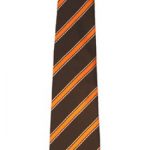On Sunday I found myself hurriedly marching up Fifth Avenue in order to make a rendez-vous. Sure I stopped a moment to snap the new Polo store under construction, but mostly I was irritably weaving in and out of tourists for 16 blocks.
As I marched the clamor of the city rang in my ears with its usual din (pointless honking is one of my biggest pet peeves about New York), and I passed perhaps a thousand people on the street. The odds, then, of passing a young couple at precisely the moment when the lady asked her beau, “Has J. Press reopened?” and actually registering the words amid the noise are so slim as to be mind-boggling. Then again I’ve been watching a lot of astronomical documentaries lately, so my mind is already pretty boggled.
In fact J. Press has not found a new location, but, I’d just been told a few hours before, is still scouting the dearth of suitable locations in Midtown East. Earlier that day I’d attended a small trade show hosted by Esquire, where Onward Kashiyama was showing the York Street brand. The company’s COO was there and brought me up to speed on company news.
The biggest development is that all of the company’s product lines — J. Press and York Street, the US and Japanese markets — will be brought under one design studio. And no surprise, they’re opting for Tokyo over New York. It’s a Japanese company, after all.
Denizens of Tradsville have previously bantered about J. Press Japan’s offerings, with some saying many of the products look better than US products and why can’t we get them here. We’ll have to wait and see what changes are brought to the brand with Tokyo in charge of design and merchandising.
I’m planning to do a Q&A with the COO to cover all that’s going on with J. Press, so stay tuned. — CHRISTIAN CHENSVOLD











When you sellout–you sellout!
In any case, it will be interesting to see what develops from this.
Best Regards,
Heinz-Ulrich von B.
My mind says, too short jackets, too slim cut, and too tight pants. All designed along the Tom Ford ideas. Thank goodness for Hickey, Mercer, and JB Britches.
Sad news. The clothes at J.Press Japan are pretty low quality stuff, mostly Made in China. Also, most jackets are darted and you are just as likely to see pleats as not. Slim cut, as you would expect, given how much thinner Japanese are relative to Americans, but its not like there is any shortage of that.
Anyone know if they are hiring?
An MIT Forum for Supply Chain Innovation survey indicated that nearly half of U.S. manufacturers are considering “reshoring”–a trend starting in high-quality, technology-driven sectors (e.g., aerospace and defense). The Boston Consulting Group indicates that Apple, Caterpillar, Ford, GE, and Whirlpool are all in such a process. This is driven by a number of issues including lower labor and energy costs, rising labor rates and currency fluctuation in many countries, as well as increasing energy and transportation costs. In the MIT study U.S. companies named corporate tax reductions and tax credits and R & D incentives as additional factors stimulating these shifts. Many in this forum would presumably agree that much of the China/Malaysian goods sold by Brooks Brothers and increasingly by J. Press warrant serious reflection before purchase. Whether or not reshoring will extend to “lower tech” issues like clothing manufacture remains to be seen, but one can hope there might evolve some novel new companies evolving in the clothing industry. Ralph Lauren seems to get the point by bringing back production of “Purple Label” to Hickey Freeman (Canadian management, but U.S. manufacture–Rochester, NY).
Brick by brick American manufacturing is trying to recover, we’ll see how this goes. However I believe Hickey Freeman has only been contracted to manufacture Blue Label (Polo) tailored garments. It will be interesting to see if it’s successful. The target customers for Blue Label are upper middle class, who have felt the middle-class squeeze and currently spend more on fewer things (buying at Walmart for daily wear to save up for that Coach bag).
Let’s hope the middle class finds it’s footing, for good taste’s sake!
Excuse my post mistake–indeed I meant to say “Blue Label.” Perhaps we are beginning to discover that an “economy” based on consumption, particularly when fueled by excessive borrowing (with artificially and disingenuous low interest rate incentives), is perhaps not tenable in the long run. Rediscovering/”reshoring” components of manufacturing (including clothing) would hopefully produce wages that would reduce the middle-class squeeze and enhance the possibility of purchasing goods of a better “taste.”